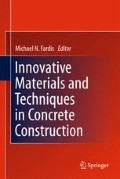Abstract
In this paper a mix design methodology for Lightweight Aggregate Self-Compacting Concrete (LWASCC) is presented based on the packing density theory. The proposed methodology targets: (i) the minimization of the voids volume associated to the packing of the coarse aggregate fractions (4–16 mm); (ii) the maximization of the packing density of the cementitious materials in the paste; (iii) the minimization of the water-to-cementitious materials volumetric ratio (V w /V cm ) in the mortar; and (iv) the optimization of the measurable workability features of the produced LWASCC mixtures. Points (ii) and (iii) are achieved using the “wet packing method” in the cementitious paste and mortar phases, along with standard consistency tests (mini slump-flow for the cementitious paste; mini slump-flow and mini V-funnel for the mortar). The final mixture proportions are attained by determining the optimum mortar-to-aggregates packing voids ratio.
Access this chapter
Tax calculation will be finalised at checkout
Purchases are for personal use only
References
ASTM C1611/C1611M – 09be1 (2009) Standard test method for slump flow of self-consolidating concrete – Appendix X1, ASTM International, West Conshohocken, PA. doi: 10.1520/C1611_C1611M-09BE01, www.astm.org
ASTM C173/C173M – 10b (2010) Standard test method for air content of freshly mixed concrete by the volumetric method, ASTM International, West Conshohocken, PA. doi: 10.1520/C0173_C0173M-10B, www.astm.org
CEN (1998) EN 1097-3:1998. Tests for mechanical and physical properties of aggregates. Determination of loose bulk density and voids. Comite Europeen de Normalisation, Brussels
CEN (1999) EN 1097-4:1999. Tests for mechanical and physical properties of aggregates – part 6: determination of the voids of dry compacted filler. Comite Europeen de Normalisation, Brussels
CEN (2000a) EN 206-1:2000. Concrete – part 1: specification, performance, production and conformity. Comite Europeen de Normalisation, Brussels
CEN (2000b) EN 1097-8:2000. Tests for mechanical and physical properties of aggregates – part 6: Determination of particle density and water absorption. Comite Europeen de Normalisation, Brussels
Hwang CL, Hung MF (2005) Durability design and performance of self-consolidating lightweight concrete. Constr Build Mater 19:619–626
Jacobsen S, Arntsen B (2008) Aggregate packing and -void saturation in mortar and concrete proportioning. Mater Struct 41:703–716
Jones MR, Zheng L, Newlands MD (2003) Estimation of the filler content required to minimize voids ratio in concrete. Mag Concr Res 55(2):193–202
Mechtcherine V, Haist M, Hewener A, Muller HS (2001) Self-compacting lightweight concrete – a new high-performance building material. In: Proceedings of the 2nd international symposium on self-compacting concrete, Kochi, Japan
Okamura H, Ouchi M (2003) Self-compacting concrete. J Adv Concr Technol 1:5–15
Papanicolaou A, Kaffetzakis M (2009) Pumice aggregate self-compacting concrete. In: 16th National conference on concrete, Cyprus, Pafos (in Greek)
Papanicolaou C, Kaffetzakis M (2011) Lightweight aggregate self-compacting concrete: state-of-the-art & pumice application. J Adv Concr Technol 9(1):15–29
Şhamaran M, Christianto HA, Yaman İÖ (2006) The effect of chemical admixtures and mineral additives on the properties of self-compacting mortars. Cem Concr Compos 28:432–440
Shi C, Wu Y (2005) Mixture proportioning and properties of self-consolidating lightweight concrete containing glass powder. ACI Mater J 102(5):355–363
Uygunoğlu T, Topçu IB (2009) Thermal expansion of self-consolidating normal and lightweight concrete at elevated temperature. Constr Build Mater 23:3063–3069
Wong HHC, Kwan AKH (2008) Packing density of cementitious materials: part 1 – measurement using a wet packing method. Mater Struct 41:689–701
Author information
Authors and Affiliations
Corresponding author
Editor information
Editors and Affiliations
Rights and permissions
Copyright information
© 2012 Springer Science+Business Media B.V.
About this paper
Cite this paper
Kaffetzakis, M., Papanicolaou, C. (2012). Mix Proportioning Method for Lightweight Aggregate SCC (LWASCC) Based on the Optimum Packing Point Concept. In: Fardis, M. (eds) Innovative Materials and Techniques in Concrete Construction. Springer, Dordrecht. https://doi.org/10.1007/978-94-007-1997-2_8
Download citation
DOI: https://doi.org/10.1007/978-94-007-1997-2_8
Published:
Publisher Name: Springer, Dordrecht
Print ISBN: 978-94-007-1996-5
Online ISBN: 978-94-007-1997-2
eBook Packages: EngineeringEngineering (R0)

